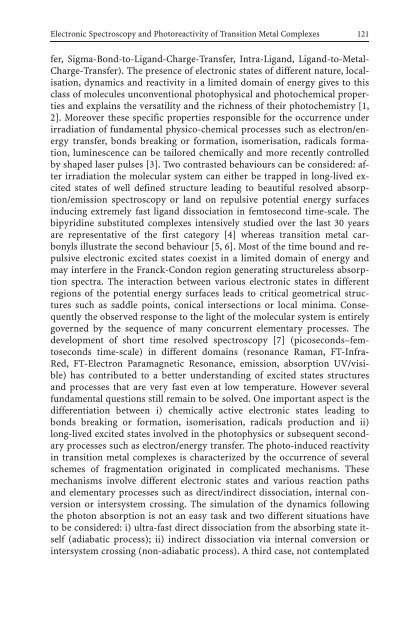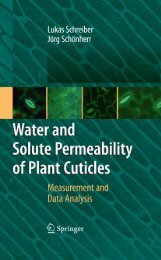Topics in Current Chemistry
Topics in Current Chemistry
Topics in Current Chemistry
You also want an ePaper? Increase the reach of your titles
YUMPU automatically turns print PDFs into web optimized ePapers that Google loves.
Electronic Spectroscopy and Photoreactivity of Transition Metal Complexes 121<br />
fer, Sigma-Bond-to-Ligand-Charge-Transfer, Intra-Ligand, Ligand-to-Metal-<br />
Charge-Transfer). The presence of electronic states of different nature, localisation,<br />
dynamics and reactivity <strong>in</strong> a limited doma<strong>in</strong> of energy gives to this<br />
class of molecules unconventional photophysical and photochemical properties<br />
and expla<strong>in</strong>s the versatility and the richness of their photochemistry [1,<br />
2]. Moreover these specific properties responsible for the occurrence under<br />
irradiation of fundamental physico-chemical processes such as electron/energy<br />
transfer, bonds break<strong>in</strong>g or formation, isomerisation, radicals formation,<br />
lum<strong>in</strong>escence can be tailored chemically and more recently controlled<br />
by shaped laser pulses [3]. Two contrasted behaviours can be considered: after<br />
irradiation the molecular system can either be trapped <strong>in</strong> long-lived excited<br />
states of well def<strong>in</strong>ed structure lead<strong>in</strong>g to beautiful resolved absorption/emission<br />
spectroscopy or land on repulsive potential energy surfaces<br />
<strong>in</strong>duc<strong>in</strong>g extremely fast ligand dissociation <strong>in</strong> femtosecond time-scale. The<br />
bipyrid<strong>in</strong>e substituted complexes <strong>in</strong>tensively studied over the last 30 years<br />
are representative of the first category [4] whereas transition metal carbonyls<br />
illustrate the second behaviour [5, 6]. Most of the time bound and repulsive<br />
electronic excited states coexist <strong>in</strong> a limited doma<strong>in</strong> of energy and<br />
may <strong>in</strong>terfere <strong>in</strong> the Franck-Condon region generat<strong>in</strong>g structureless absorption<br />
spectra. The <strong>in</strong>teraction between various electronic states <strong>in</strong> different<br />
regions of the potential energy surfaces leads to critical geometrical structures<br />
such as saddle po<strong>in</strong>ts, conical <strong>in</strong>tersections or local m<strong>in</strong>ima. Consequently<br />
the observed response to the light of the molecular system is entirely<br />
governed by the sequence of many concurrent elementary processes. The<br />
development of short time resolved spectroscopy [7] (picoseconds–femtoseconds<br />
time-scale) <strong>in</strong> different doma<strong>in</strong>s (resonance Raman, FT-Infra-<br />
Red, FT-Electron Paramagnetic Resonance, emission, absorption UV/visible)<br />
has contributed to a better understand<strong>in</strong>g of excited states structures<br />
and processes that are very fast even at low temperature. However several<br />
fundamental questions still rema<strong>in</strong> to be solved. One important aspect is the<br />
differentiation between i) chemically active electronic states lead<strong>in</strong>g to<br />
bonds break<strong>in</strong>g or formation, isomerisation, radicals production and ii)<br />
long-lived excited states <strong>in</strong>volved <strong>in</strong> the photophysics or subsequent secondary<br />
processes such as electron/energy transfer. The photo-<strong>in</strong>duced reactivity<br />
<strong>in</strong> transition metal complexes is characterized by the occurrence of several<br />
schemes of fragmentation orig<strong>in</strong>ated <strong>in</strong> complicated mechanisms. These<br />
mechanisms <strong>in</strong>volve different electronic states and various reaction paths<br />
and elementary processes such as direct/<strong>in</strong>direct dissociation, <strong>in</strong>ternal conversion<br />
or <strong>in</strong>tersystem cross<strong>in</strong>g. The simulation of the dynamics follow<strong>in</strong>g<br />
the photon absorption is not an easy task and two different situations have<br />
to be considered: i) ultra-fast direct dissociation from the absorb<strong>in</strong>g state itself<br />
(adiabatic process); ii) <strong>in</strong>direct dissociation via <strong>in</strong>ternal conversion or<br />
<strong>in</strong>tersystem cross<strong>in</strong>g (non-adiabatic process). A third case, not contemplated







